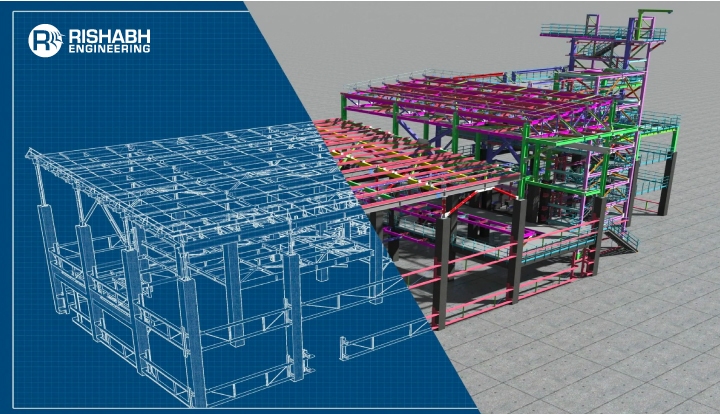
Understanding Structural Analysis And Design With Real-World Applications
Structural analysis and design help ensure the safety and stability of any plant engineering project. By understanding and predicting how structures in the industrial set-up respond to various stresses. The engineers can create infrastructure that withstand both everyday use and unexpected forces, ensuring longevity and reliability in an ever-evolving architectural landscape. Therefore, structural stress analysis is critical for assuring a structure’s safety, reliability, and lifespan, ranging from bridges and buildings to aircraft and ships.
This blog will discuss structural analysis & design, its various types, why it is performed, its requirements, and Rishabh Engineering’s real-world applications.

What Is Structural Analysis And Design?
Structural analysis & design is an engineering procedure that assures buildings and structures can withstand loads and stresses. It entails evaluating structures’ integrity, strength, and stability and designing safe and efficient buildings and infrastructure using mathematical calculations and simulations. Structural stress analysis is also an important part of structural analysis and design. It determines how forces and loads impact a structure’s materials and components. Engineers can forecast possible failure sites and improve design to assure the structure’s safety, stability, and durability. This procedure assures that buildings and infrastructure can endure real-world use. Analyzing structural stress assists engineers in designing structures that can handle various loads without failure – it is measured in terms of force per unit area, such as Pascals (Pa) or pounds per square inch (psi).
Importance Of Structural Analysis And Design
It is essential for numerous reasons:
- Safety Assurance: This guarantees that structures can resist expected loads and environmental conditions without compromising safety.
- Failure Prevention: Analyzing stress concentrations and weak areas lowers the likelihood of structural failure.
- Optimized Design: Analyzing designs helps improve performance and longevity while reducing material and construction costs.
- Compliance: Ensuring compliance with industry-specific regulatory standards and codes to preserve public safety and the environment.
- Performance Enhancement: Understanding stress distribution optimizes maintenance schedules and operating efficiencies, improving performance.
Types Of Structural Analysis
Structural analysis incorporates multiple methodologies geared to designing & developing different types of structures across varied loading conditions:
- Static Analysis: Evaluates stresses under constant loads without considering dynamic influences.
- Dynamic Analysis: Considers how time-dependent forces, vibrations, and resonance affect structural integrity.
- Finite Element Analysis (FEA): Utilizes a computational method for simulating complex stress distributions and behaviors within a structure.
- Fatigue Analysis: Determines how repeated or variable loads over time can result in accumulated damage and eventual failure.
- Buckling Analysis: Predicts the instability and collapse of thin structures under compressive stresses.
Steps For Structural Analysis And Design
Listed below are the key steps for structural design & analysis as applied in a multidiscipline engineering scenario;
Step 1: Modeling
- Create a Mechanical Framework: Begin with an architectural model and simplify it to focus on the load-bearing components, such as foundations, columns, beams, frames, trusses, and other critical parts.
- Simplify the Model: Convert the load-bearing structure into a more straightforward, calculation-ready model through a process called schematization.
- Include Structural Elements: Make sure your model includes necessary components such as beams, columns, struts, ties, slabs, shear walls, and membranes.
- Material Selection: Choose appropriate materials that are both safe and cost-effective, such as structural steel, reinforced concrete, or timber.
- Assume Dimensions: Determine the initial dimensions for each piece to compute self-weight for load analysis.
- Define Boundary Conditions: Determine all structural members’ internal and external boundary conditions.
Step 2: Load Analysis
- Identify Loads: List all conceivable loads, such as dead loads (self-weight), living loads (occupancy and movement), wind loads, snow loads, earthquake loads, earth pressure, water and ice loads, thermal loads, and dynamic loads.
- Use Design Codes: Refer to structural design codes to identify the values and combinations of these loads.
- Evaluate Load Combinations: Assess how different loads interact and determine the worst-case scenarios for the structure.
Step 3: Structural Analysis
- Perform Calculations: Analyze how the structure behaves under various load combinations.
- Global Analysis: Conduct a comprehensive analysis to obtain internal force diagrams (shear, bending moment, normal, torsion), reactions, and deformations/deflections.
- Use Software: Employ structural engineering software with Finite Element Analysis (FEA) capabilities for complex structures to ensure accurate and efficient computations.
Step 4: Structural Design
- Dimension Elements: Based on analysis results, dimension the different parts of the structure.
- Verify Requirements: Check the initial dimensions against design requirements for stability, strength, and stiffness. Refer to relevant design codes for these criteria.
- Optimize Design: If requirements are unmet, adjust dimensions and repeat the analysis and design steps until they are satisfied.
- Document Specifications: Finalize dimensions and material details, including reinforcement areas for concrete elements.
Step 5: Detailing
- Placement of Details: Decide where to place structural details and connections, such as beam or column splices and beam-column connections.
- Specify Reinforcement and Connections: Detail the reinforcement bars, bolt grades, number of bolts, weld throat thickness, and other connection specifics.
- Enhance Ductility and Cost-Efficiency: For example, in concrete structures, balanced reinforcement increases ductility. In steel structures, strategic placement of connections can reduce costs.
By following these essential steps, Rishabh Engineering ensures a comprehensive and efficient approach to structural analysis, resulting in safe, reliable, and cost-effective engineering solutions.
Considerations For Structural Analysis And Design
Effective structural analysis & design are critical to the safety, dependability, and lifespan of engineering projects. Several essential factors must be considered to achieve these goals.
- Material Selection: Understanding and selecting the correct materials is critical. Engineers must assess each material’s strength, ductility, toughness, and fatigue resistance. Different materials respond differently to stress; thus, choosing the right one is critical to ensure the structure’s performance and longevity.
- Load Analysis: It is critical to assess the various loads a structure can bear accurately. This covers static, dynamic, cyclic, and impact loads and environmental elements such as wind, earthquakes, and temperature changes. Proper load estimation guarantees that the building can endure these forces without sacrificing safety.
- Structural Geometry: The design and shape of a structure influence how stress is distributed throughout it. Complex geometries may create areas of concentrated stress, requiring careful analysis and mitigation. Uniform stress distribution is key to avoiding weak points and potential failures.
- Safety Margins: Safety concerns must be incorporated into the design process to account for uncertainties in material qualities, load projections, and anticipated construction variations. These safety margins serve to strengthen the structure’s resistance to unexpected situations and errors.
- Computational Tools: Modern computational approaches, such as Finite Element Analysis (FEA), enable accurate modeling and simulation of complicated structures. These techniques allow engineers to estimate stress distribution and likely failure spots properly. The credibility of these assessments is determined by the quality of the input data and the model assumptions.
- Adherence to Standards: To guarantee that structures satisfy the minimal safety and performance criteria, they must adhere to industry standards and guidelines. Engineers must stay current on the newest changes to these regulations and incorporate them into their design procedures.
- Lifecycle Considerations: Engineers should evaluate the structure’s complete lifecycle, from building to operation and decommissioning. This includes evaluating the impact of aging, wear and tear, maintenance requirements, and potential future adjustments. Designing for durability and simplicity of maintenance can significantly increase a structure’s life.
- Environmental Sustainability: Sustainable design principles are becoming more relevant in structural engineering. Engineers should strive to reduce the environmental impact of their projects by using sustainable materials, optimizing resource consumption, and preparing for end-of-life recyclability.
- Collaborative Efforts: Successful structural design necessitates good coordination among diverse teams, which include architects, contractors, and stakeholders. Clear communication ensures that all project aspects are coordinated and assists in identifying and resolving possible issues early in the process.
Codes & Standards For Structural Analysis & Design
To govern structural design and analysis, some industries have produced rules and standards:
International Codes
- International Building Code (IBC): Provides precise criteria for building design and construction, including structural safety, load requirements, and overall integrity.
- International Residential Code (IRC): Focuses on residential constructions and establishes rules for the design and construction of homes and comparable buildings.
American Codes
- ACI 318: Specifies the requirements for designing and constructing reinforced concrete structures.
- AISC 360: Provides extensive recommendations for the design of steel structures, including strength and stability factors.
- ASCE 7: Outlines the standards for calculating various loads, including dead, live, wind, and seismic loads.
European Codes
- Eurocode 1 (EN 1991): Specifies the types of loads that structures must be designed to resist, including permanent, variable, and accidental loads.
- Eurocode 2 (EN 1992): Provides guidelines for designing and constructing concrete structures, including reinforced and prestressed concrete.
- Eurocode 3 (EN 1993): Outlines the requirements for the design of steel structures, focusing on material properties and load considerations.
British Standards
- BS 5950: Addresses the structural use of steelwork in buildings, providing guidelines for the UK’s design and construction of steel structures.
- BS 8110: Offers specifications for designing concrete structures, including aspects related to material properties and load resistance.
Canadian Codes
- CSA S16: Outlines the requirements for designing and constructing steel structures in Canada.
- CSA A23.3: Provides guidelines for the design of concrete structures, focusing on load and material considerations in Canada.
International Organization For Standardization (ISO)
- ISO 2394: Provides international guidelines for assessing and ensuring the reliability and safety of structures throughout their lifespan.
Seismic Design Codes
- Uniform Building Code (UBC): Offers requirements for designing structures to withstand seismic forces, particularly important in earthquake-prone regions.
- NEHRP Guidelines: Provide guidelines and recommend practices for earthquake-resistant design and construction.
When To Conduct Structural Analysis And Design?
Performing structural analysis is crucial for ensuring safety by assessing structural integrity and identifying potential failure spots.
Structural stress analysis should be undertaken;
- During Design:To ensure that designs fulfill safety and performance standards.
- Before construction, assess the feasibility and ensure structural integrity.
- During the operation, stress levels are monitored to identify problems early.
- Following modifications: Assessing the effects on structural integrity and performance.
Use Cases Of Rishabh Engineering – Structural Analysis & Design
Case 1: Structural & Piping Stress Analysis For OC & RAS Systems
Project: Piping Stress & Structural Stress Analysis for OC & RAS Systems
Client: US-based engineering and consulting services provider specializing in pipe support engineering/design and pipe flexibility analysis across central piping installations
Objective: The client asked Rishabh Engineering to undertake a thorough pipe and structural stress analysis for OC & RAS Systems to guarantee that the system supports could withstand the necessary pipe loads. The project included an odor control system (OC) using fiber glass piping (FRP) and a return activated sludge (RAS) ductile iron system. Rishabh Engineering provided a complete piping stress summary, restraint summary report, and pipe support structure analysis report, ensuring the system’s robustness and reliability during operational loads.
Case 2: Structural Stress Analysis Of Cold Box
Project: Structural Analysis Of Cold Box Using STAAD.Pro
Client: Cryogenic gas processing equipment manufacturer
Objective: Conduct a comprehensive structural stress analysis of the cold box to ensure safety and integrity under operational conditions. We utilized STAAD Pro for 3D modeling, dynamic and static analyses, and lifting assessments. The scope included analyzing transportation stability, design welded connections and anchor bolts, and identify mitigation measures. We delivered a detailed report with optimization recommendations.
Case 3: Structural Stress Analysis For Waste Heat Recovery Units (WHRU) Using STAAD Pro
Project: Structural Analysis And Structural Design Drawings For Waste Heat Recovery Units
Client: A large EPC conglomerate based in the UK, renowned for its diverse portfolio in commercial infrastructure, heavy industrial, and energy sectors
Objective: The scope involved structural stress analysis for waste heat recovery units using STAAD Pro (Offshore Platform). Rishabh Engineering used STAAD.Pro to conduct a structural study on two WHRUs, calculate foundation load data, and design anchor bolts. We also completed structural analysis for the lifting and shipping of various WHRU components, assuring stability and integrity throughout the activities. This included examining WHRU support, accompanying pipe supports, and the supporting platform. The project also included generating structural design drawings for WHRU supports, pipe supports, and platforms and thoroughly evaluating fabrication drawings to ensure they followed the structural design. Deliverables included a structural stress analysis report, lifting and transportation analysis, foundation load data, and structural design drawings with a comprehensive review of Fabrication Drawings, ensuring the project met the highest engineering standards.
Final Words
Structural analysis and design are essential for ensuring construction safety and stability. Engineers can create buildings and infrastructure that withstand daily use and unforeseen forces by understanding how structures respond to various stresses. This blog covered key aspects of structural analysis, including types, purposes, and real-world applications. Each step is crucial for developing safe and reliable engineering solutions, from modeling and load analysis to detailed design, ensuring that structures meet and exceed safety and performance standards. As part of the process, the engineers from our structural analysis & design services team ensure the safety, dependability, and lifespan of structures ranging from bridges and buildings to ships by calculating internal forces within materials caused by external loads and environmental variables.
Seek Help With Structural Analysis & Design?
Our team can help optimize design, prevent failure, and ensure longevity of structures across various industries.
Frequently Asked Questions (FAQ)
Q: What are the things you need to know about structural analysis & design from stress standpoint?
A: Based on our experience, listed below are essentials you need to know about structural analysis & design from a stress standpoint;
- Stress Concentrations: Areas with increased stress levels due to geometry, material faults, or loading conditions.
- Material Properties: Stress behavior, including elasticity, yield strength, and ductility, affects how materials react to applied forces.
- Load Types: Tension, compression, bending, and torsion can affect stress distribution and critical points in structures.
- Environmental Factors: These include parameters such as temperature, corrosion, and seismic activity that can affect structural stress and durability.
- Risk Assessment: Identifying and mitigating structural stress hazards ensures the structure performs safely and reliably throughout time.
Related Blogs
Related Blogs
Best Structural Engineering Software for Accurate Analysis
Finding tools that simplify and improve the accuracy of the…
Detailed Engineering Considerations for Project Success
Engineering projects today require meticulous planning and execution across various…


